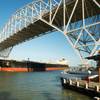First LNG Vessel Transits Expanded Panama Canal
Today, the Panama Canal marked another milestone with the transit of the first-ever liquefied natural gas (LNG) carrier through its expanded locks.
Shell-chartered Maran Gas Apollonia—measuring 289 meters in length and 45 meters in beam—arrived Monday from the Sabine Pass LNG Terminal on the U.S. Gulf Coast, signaling the arrival of the highly-anticipated segment to the waterway.
“The transit of the first LNG vessel through the new Panama Canal locks is a milestone in the waterway’s history,” said Panama Canal Administrator and CEO Jorge L. Quijano. “LNG trade will greatly benefit from the Expansion, and we look forward to welcoming even more LNG vessels through our great waterway. This transit marks the beginning of a new era that will result in cleaner and lower cost energy for the world.”
The Expanded Canal can accommodate 90 percent of the world’s LNG tankers, which will have a major impact on global LNG flows and offer numerous benefits to shippers.
For example, with the United States poised to become one of the world’s top LNG exporters in the next five years, the Canal will allow vessels departing the U.S. East and Gulf Coast for Asia to enjoy significant reductions in voyage times (up to 22.8 days roundtrip), making U.S. gas deliveries to major Asian importers very competitive. Vessels departing the U.S. Gulf Coast for the West Coast of South America will similarly experience generous time savings.
In addition, LNG ships from the production plants in Trinidad and Tobago could head to Chile where LNG is regasified and distributed for energy-producing purposes. For this route, the Expanded Canal provides savings of 6.3 days in transit time compared to the Magellan Strait.
Providing further advantage, the Canal instituted a new tolls structure to offer substantial cost savings to LNG vessels conducting roundtrip voyages. The new tolls reduce ballast fees for LNG customers who use the same vessel for a roundtrip voyage as opposed to using an alternate route, so long as the transit in ballast is made within 60 days after the laden transit was completed.
“The Panama Canal makes history today with the opening of its gates to new opportunities for world energy with the transit of the first LNG vessel,” said José Ramón Arango, Senior Specialist for the Liquid Bulk Segment at the Panama Canal Authority. “Our reliable connection is an important enabler in the development of new LNG trade by reducing the distances that link world LNG markets and providing access to clean energy resources.”
In addition to today’s LNG transit, the Expanded Panama Canal has welcomed 53 vessels since its June 26 Inauguration, including 22 liquefied petroleum (LPG) vessels, 28 containerships and two vehicle carriers. And the number of reservations that the Canal has received thus far from various types of Neopanamax vessels is more than 229, and growing by the week. This increasing demand is further evidence of the maritime industry’s continued trust in the Expanded Canal and the impact it will have on the future of global maritime trade.











